How We Added Millions in ARR to Structure Studios’ Revenue
Last updated: May 3rd, 2023
Structure Studios, based in Nevada, specializes in turning 2D drawings and blueprints into navigable 3D environments for landscaping contractors.
When they first approached us, they’d been experiencing a number of issues with their paid media and SEO efforts. And like many of the B2B SaaS companies we’d worked with, the source of their problems came down to the most common underlyingproblem we’ve seen in the market: they’d been deploying a buffet of digital marketing tactics without a well-defined strategy.
Up until that point, marketing their SaaS product consisted of an ad hoc Google Ads strategyaimed at bottom-of-funnel keywords, a couple live Facebook Ads (also with a bottom-of-funnel focus), and partially optimized product pages that weren’t gaining traction in organic search rankings.
They did not have any offers for prospects who weren’t ready to buy, an attribution model beyond last click, or any way of segmenting leads by size or quality.
At the time, our team had been working to develop an antidote to this problem of tactics without strategy. We now call it the Predictable Growth Methodology.
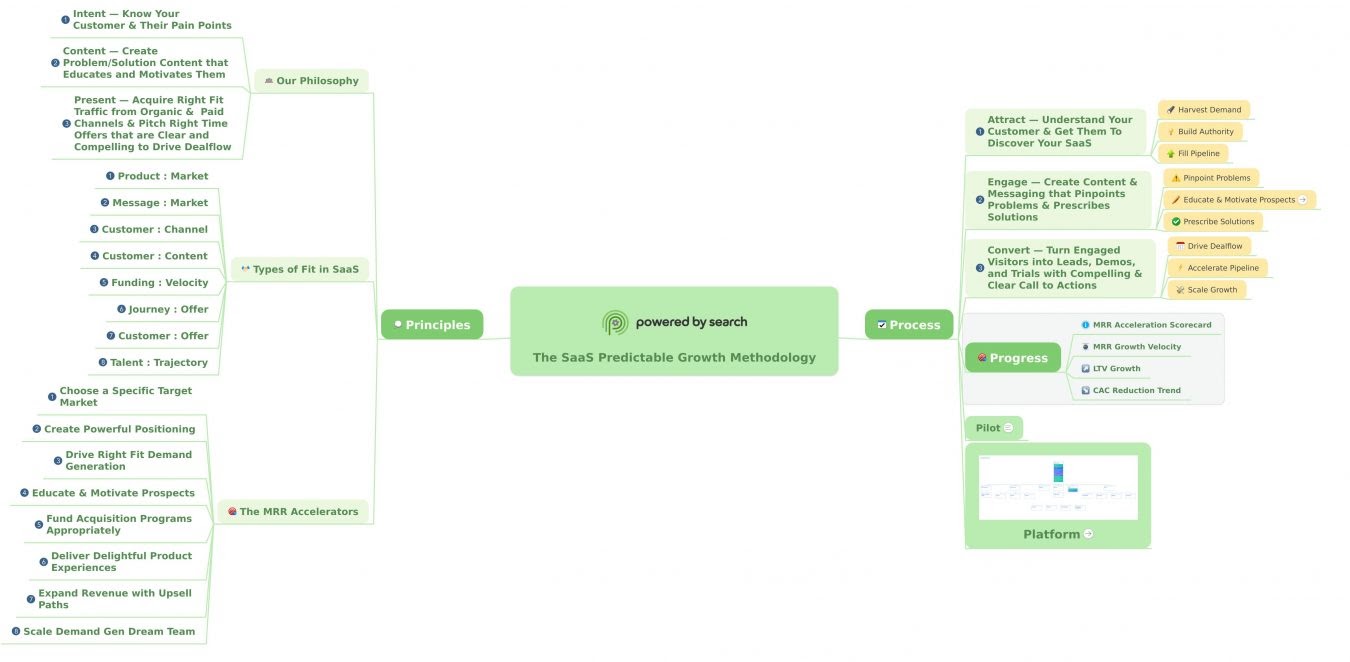
Predictable Growth was our effort to combine the knowledge our team had gained helping dozens of B2B SaaS companies grow, and create a framework that we could use to show our clients how we would get them repeatable, reliableresults.
Instead of thinking of each tactic as their own individual effort, Predictable Growth helps SaaS marketers coordinate their tactics to ensure they’re working together — and this helps them breach the growth ceilings they otherwise tend to reach with their marketing.
It’s designed so that any B2B SaaS business, no matter what stage or state they are in, can systematically pinpoint their marketing problems and opportunities, and implement changes to grow revenue in a strategic way. And this is the strategy we used to help Structure Studios grow their ARR drastically over a 24 month period.
In this article, we do a deep dive into:
- The specific challenges they came to us with (only some of which they were aware of)
- The technical SEO and content updates we made that led to a position 1 Google ranking for their highest value keyword (they continue to sit at the top of search results)
- How we revamped their paid search and social ads to reach a wider audience, implement attribution, and improve lead quality
If you’re a B2B SaaS company and you’ve been experiencing problems similar to Structure Studios, schedule a Free SaaS Scale Sessionto learn more about how we can help your business grow through paid media and SEO.
The Challenges Structure Studios Knew About (and the Ones They Didn’t)
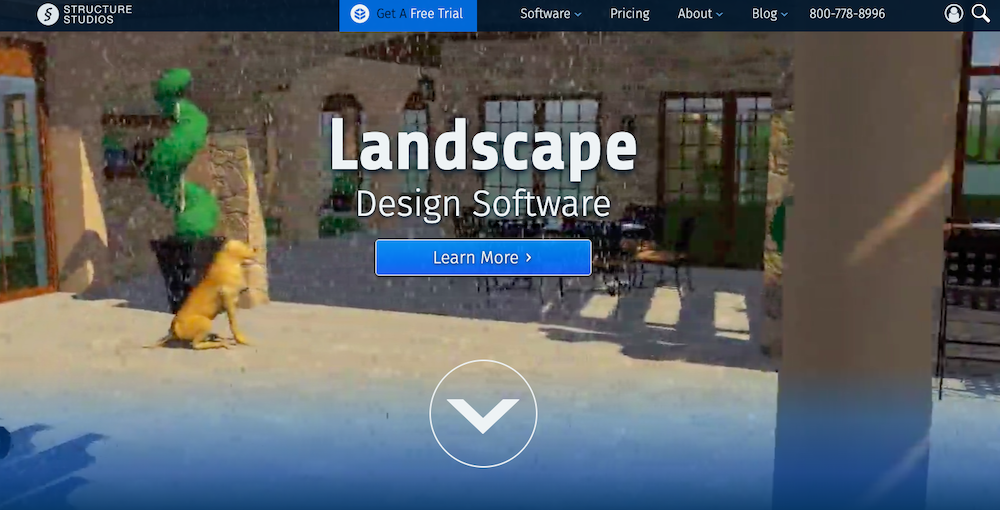
When Structure Studios came to us, there were three particular challenges on their radar:
- They’d been trying to rank for the keyword “landscape design software” for a year and hadn’t breached page 1 — which they suspected was due to technical SEO issues
- They’d reached a ceiling with their ad performance through both search and social, and thought there was more opportunity there if they could figure out how to improve those efforts
- They knew they weren’t following tracking and attribution best practices, but didn’t have the time or know-how to get it sorted out
But deeper analysis through our Predictable Growth process uncovered lead quality challenges as well.
Like many B2B SaaS companies, Structure was using free trial signups as the KPI for their marketing. When they contacted us, they were already generating a fair amount of traffic to their website, and that traffic was converting into more signups than they thoughtthey needed to justify their marketing spend. That is, they believed that their customer acquisition cost (CAC) per free trial was relatively low.
But when we looked under the hood, correlating data from Google Analytics with data from Hubspot, a more complicated picture emerged. As it turned out, relatively few of Structure Studios’ free trial signups were associated with the kind of B2B companies that are their ideal customers. The other signups were either tiny, one-man-band landscaping companies, or homeowners working on ambitious backyard renovations, which is to say: unqualified visitors.
In reality, most free trial users weren’t converting to sales at anywhere near the rate that Structure hoped for. It also meant that their CAC was higher than they’d thought.
What follows are the updates we made to their SEO and paid ad strategies, including how we got them a position 1 Google ranking in about 90 days, and how we refined their paid ads funnel to reach more of the right new customers.
The SEO Updates That Led to a Position 1 Ranking For Their Highest Value Product Page
A big part of Predictable Growth is prioritizing actions based on factors like effort, impact, and the time certain tactics take to work. By being able to visually see the different steps that need to happen and fit together to reach your goals, it helps us to choose the orderin which we tackle individual tactics.
Since SEO takes time to work, we began with the challenge of getting Structure to rank on page 1 of search results for their highest value keyword.
Our process was to evaluate their website for technical SEO health, and also the content of their product page for relevance and authority on the topic.
Technical SEO Fixes — Consolidating Similar Pages to Prevent Cannibalization
Structure’s hunch that they had technical SEO issues turned out to be correct. We found that they had multiple pages on their site competing for their target keyword ‘landscape design software.’
This is referred to as “cannibalization” — and it’s a common SEO mistakethat can lead search engines to limit rankings. Instead of one page getting all the SEO value, it’s split between multiple pages, and none of the pages end up ranking as high as they could as a result. This is why consolidating similar pages is a key part of our SEO strategy for SaaS companies.
In Structure’s case, we implemented a cleaner content architecture so that their website had a definitive hub for ‘landscape design software,’ and also redirected similar pages to eliminate cannibalization.
Then we moved on to work on updating their main product page.
Product Page Content Updates — Increasing Topical Relevance and Authority
We have found that — in addition to following on-page SEO best practices — matching search intent and comprehensiveness are two of the most important factors in getting pages to rank.
Many SaaS companies think of SEO as primarily on-page optimization. For example, making sure heading tags include a page’s target keyword, or that relevant and related keywords are included throughout a page. What they often miss are the key elements of topical relevance and authority. And that’s what we found Structure had been missing.
So our approach was to:
- Review the content of existing top search results to understand what Google was already rewarding for that topic, and see the standard we’d need to surpass to get a top ranking
- Work with their team to inject further detail into their product page — centered around describing their prospects’ pain points and the ways in which their product helped to solve them
These steps helped us to simultaneously make their page more comprehensive and a better match to the intent of searchers.
Ultimately, the page covered the topic with more depth than any of their competitors, and within 90 days (a short timeframe for SEO) they ended up in position 1 for their target keyword.

Note: Their landscaping design software pageis still live and ranking above the fold on page 1 of search results.
Once we’d finished our technical SEO and content updates, we began working to improve the results of their paid ads through Google and Facebook.
Refining Structure’s Paid Ads: Setting Up Attribution, Expanding Their Funnel, and Increasing Lead Quality
To recap, the state of Structure’s paid ads when we began working with them included:
- Ad hoc Google and Facebook Ads aimed at bottom-of-funnel prospects
- No offer for prospects who weren’t yet ready to buy
- No attribution model for tracking lead generation beyond last click
- No segmentation of leads by size or quality
Our plan was to expand their funnel to include potential customers who were earlier in the buyer’s journey (mid and top of funnel prospects), while filtering unqualified visitors out. And then to use improved messaging, content, and offers to guide them toward purchasing the Structure solution that best fit their specific needs.
Enhancing Attribution and Tracking For Google and Facebook Ads
In the past, Structure’s Google Ads objectives had been limited to tracking any interaction a visitor had with their website, which meant they lacked a way to sort and qualify visitors through their analytics.
A key step in implementing Predictable Growth is to set up proper tracking for measuring results. As the old adage goes, “You can’t improve what you don’t measure.” So first we set up Google Analytics to sort visitors who arrived via search into useful categories: lead, free trial user, purchaser.
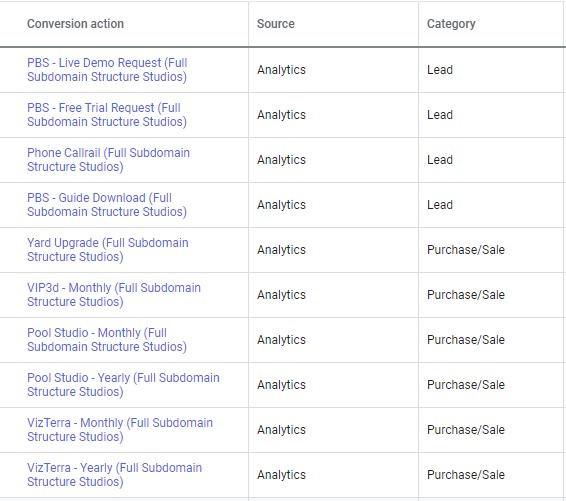
We defined negative keywords to filter out B2C customers (the ambitious homeowners we described above), and set up similar objectives in Facebook ads.
The function of this was to begin getting Structure’s message in front of the right audiences, and break those audiences down into buckets according to their readiness to buy.
We used copy designed to have professional landscapers self-identify with their ads:

This allowed us to draw in more of their idealprospects while screening out unqualified ones.
In addition, we expanded Structure’s ads to target the many subcategories of landscape design: from decking and pergolas, to fencing, to pools and gardens. And we mapped related keywords to the corresponding landing pages on their site.
That way, for example, landscapers looking specifically for pergola-design assistance, would see exactly that when they landed at Structure Studios’s website.
From there, we updated their landing pages to appeal more to prospects higher in the funnel.
Adding Offers for Mid and Top of Funnel Prospects
Because Structure had been so focused on acquiring customers who were already seeking a landscaping software solution, they had neglected to provide the sort of educational content that would guide higher funnel prospects toward considering their SaaS solution.
Ads would take customers directly to a free trial sign-up page, which said little about how Structure’s products could help them improve their business:
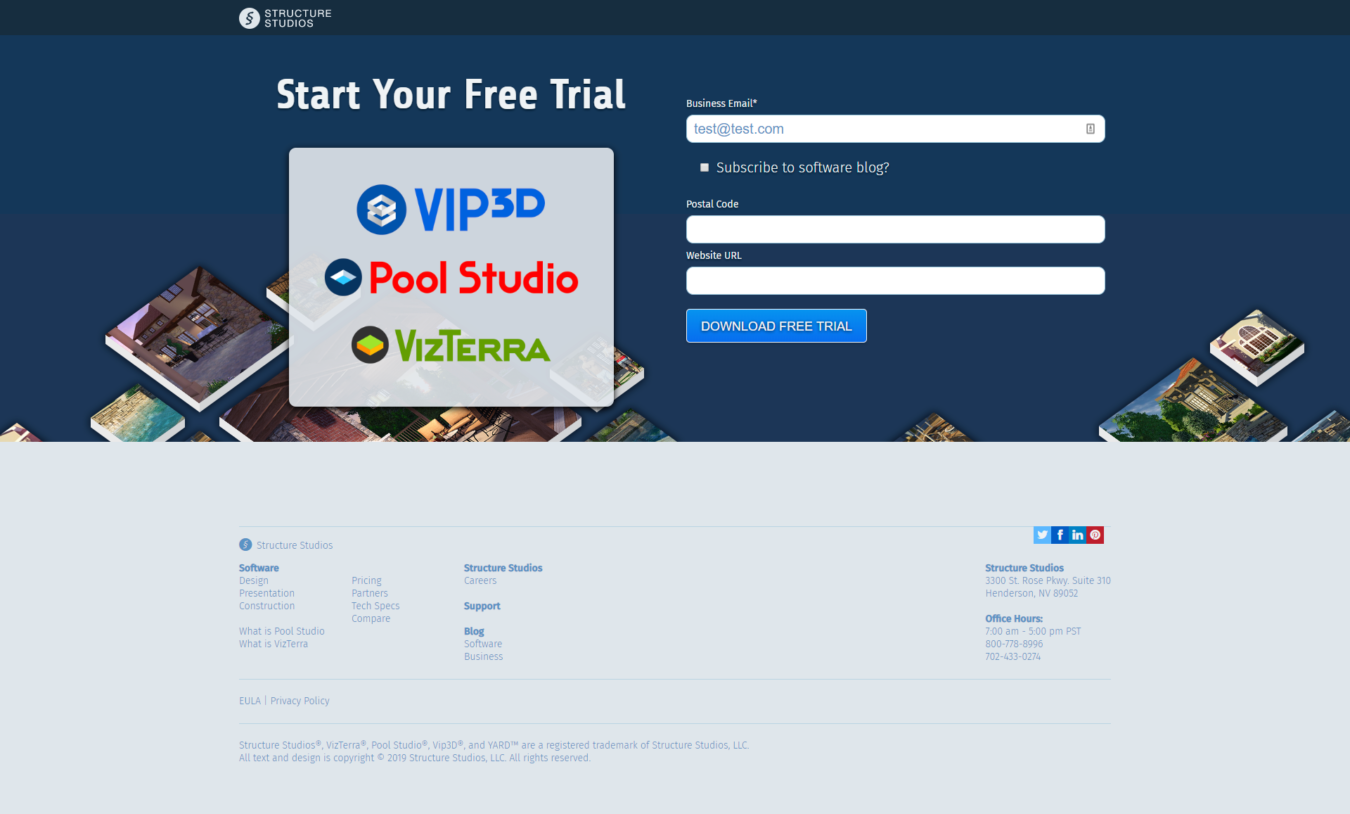
But a key part of implementing Predictable Growth is to ensure you’ve developed messaging and offers for prospects at all different levels of the funnel, not just top or bottom or mid-funnel.
So we helped them put together a landing page featuring a video describing how their software works, and testimonials from users who’d won bigger projects and clients with their product. It would function to help pro landscapers understand why signing up for a free trial with Structure was the right move to make — regardless of their initial level of product awareness.
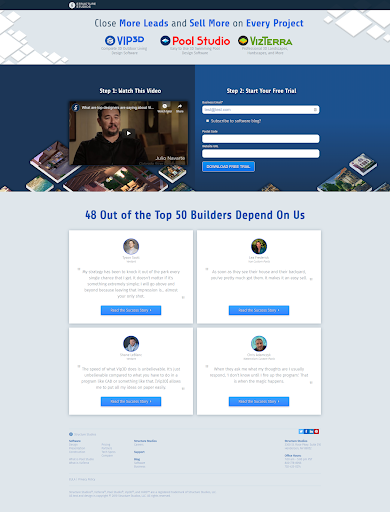
Once their tracking and attribution issues had been addressed, and their landing pages adjusted to improve conversion rates with prospects throughout their sales funnel, what remained was to use Google and Facebook Ads to drive qualified traffic to those pages.
Examples of the Paid Search and Social Media Ads We Created
We made sure that high funnel prospects started seeing ads designed to illustrate the pain points that Structure Studios excelled at addressing, showcasing how a 3D landscaping product might elegantly solve problems that these landscapers didn’t even know they had.
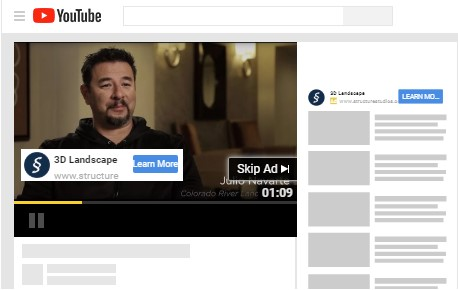
Meanwhile, for pro landscapers that were more mid-funnel prospects (ie. they were aware they had a problem), we designed ads that mirrored their pain points, suggesting how Structure could help them get their clients to better see their vision — and spring for big, lucrative design and construction projects.
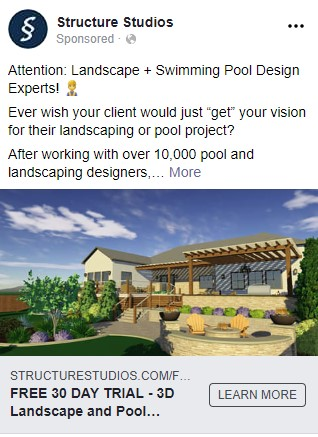
Finally, for bottom of funnel prospects — the one’s who’d already been educated about Structure Studios’ software — we initiated a remarketing campaign, designed to keep our client top-of-mind when shopping for landscape design SaaS solutions.

If effect, we’d created a machine to continuously draw in new ideal prospects, and deliver them the messaging and offers most appropriate to their stage in the buyer’s journey, growing Structure Studios’ annual revenue by 50% in the process.
Want to Trade In Tactics-Without-Strategy For Predictable Growth?
Structure Studios’ story is not unlike the story of most of the SaaS businesses we work with. With an endless array of tactics at our fingertips, it’s difficult to figure out which ones to choose, and importantly — how they fit together to produce the results they’re meant to.
If you’re a B2B SaaS business and you’d like to learn more about how we can help you grow through paid media and SEO, schedule a Free SaaS Scale Session. If you just want to learn more about ouragency’s work, check out our Predictable Growth Methodology.
What you should do now
Whenever you’re ready…here are 4 ways we can help you grow your B2B software or technology business:
- Claim your Free Marketing Plan. If you’d like to work with us to turn your website into your best demo and trial acquisition platform, claim your FREE Marketing Plan. One of our growth experts will understand your current demand generation situation, and then suggest practical digital marketing strategies to hit your pipeline targets with certainty and predictability.
- If you’d like to learn the exact demand strategies we use for free, go to our blog or visit our resources section, where you can download guides, calculators, and templates we use for our most successful clients.
- If you’d like to work with other experts on our team or learn why we have off the charts team member satisfaction score, then see our Careers page.
- If you know another marketer who’d enjoy reading this page, share it with them via email, Linkedin, Twitter, or Facebook.